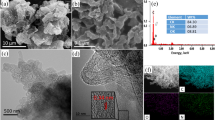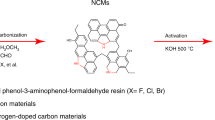Abstract
The oxygen reduction reaction (ORR) is a fundamental reaction for energy storage and conversion. It has mainly relied on platinum-based electrocatalysts, but the chemical doping of carbon-based materials has proven to be a promising strategy for preparing metal-free alternatives. Nitrogen doping in particular provides a diverse range of nitrogen forms. Here, we introduce a new form of nitrogen doping moieties —sp-hybridized nitrogen (sp-N) atoms into chemically defined sites of ultrathin graphdiyne, through pericyclic replacement of the acetylene groups. The as-prepared sp-N-doped graphdiyne catalyst exhibits overall good ORR performance, in particular with regards to peak potential, half-wave potential and current density. Under alkaline conditions it was comparable to commercial Pt/C, and showed more rapid kinetics. And although its performances are a bit lower than those of Pt/C in acidic media they surpass those of other metal-free materials. Taken together, experimental data and density functional theory calculations suggest that the high catalytic activity originates from the sp-N dopant, which facilitates O2 adsorption and electron transfer on the surface of the catalyst. This incorporation of chemically defined sp-N atoms provides a new synthetic route to high-performance carbon-based and other metal-free catalysts.
This is a preview of subscription content, access via your institution
Access options
Access Nature and 54 other Nature Portfolio journals
Get Nature+, our best-value online-access subscription
$29.99 / 30 days
cancel any time
Subscribe to this journal
Receive 12 print issues and online access
$259.00 per year
only $21.58 per issue
Buy this article
- Purchase on Springer Link
- Instant access to full article PDF
Prices may be subject to local taxes which are calculated during checkout





Similar content being viewed by others
References
Winter, M. & Brodd, R. J. What are batteries, fuel cells, and supercapacitors? Chem. Rev. 104, 4245–4270 (2004).
Debe, M. K. Electrocatalyst approaches and challenges for automotive fuel cells. Nature 486, 43–51 (2012).
Cheng, F. & Chen, J. Metal–air batteries: from oxygen reduction electrochemistry to cathode catalysts. Chem. Soc. Rev. 41, 2172–2192 (2012).
Chen, A. & Holt-Hindle, P. Platinum-based nanostructured materials: synthesis, properties, and applications. Chem. Rev. 110, 3767–3804 (2010).
Gasteiger, H. A. & Markovic, N. M. Just a dream—or future reality? Science 324, 48–49 (2009).
Wang, Y. J. et al. Carbon-supported Pt-based alloy electrocatalysts for the oxygen reduction reaction in polymer electrolyte membrane fuel cells: particle size, shape, and composition manipulation and their impact to activity. Chem. Rev. 115, 3433–3467 (2015).
Tang, H. et al. Molecular architecture of cobalt porphyrin multilayers on reduced graphene oxide sheets for high-performance oxygen reduction reaction. Angew. Chem. Int. Ed. 52, 5585–5589 (2013).
Dai, L., Xue, Y., Qu, L., Choi, H. J. & Baek, J. B. Metal-free catalysts for oxygen reduction reaction. Chem. Rev. 115, 4823–4892 (2015).
Liu, X. & Dai, L. Carbon-based metal-free catalysts. Nat. Rev. Mater. 1, 16064 (2016).
Gong, K., Du, F., Xia, Z., Durstock, M. & Dai, L. Nitrogen-doped carbon nanotube arrays with high electrocatalytic activity for oxygen reduction. Science 323, 760–764 (2009).
Liang, J., Jiao, Y., Jaroniec, M. & Qiao, S. Z. Sulfur and nitrogen dual-doped mesoporous graphene electrocatalyst for oxygen reduction with synergistically enhanced performance. Angew. Chem. Int. Ed. 51, 11496–11500 (2012).
Yang, D.-S., Bhattacharjya, D., Inamdar, S., Park, J. & Yu, J.-S. Phosphorus-doped ordered mesoporous carbons with different lengths as efficient metal-free electrocatalysts for oxygen reduction reaction in alkaline media. J. Am. Chem. Soc. 134, 16127–16130 (2012).
Silva, R., Voiry, D., Chhowalla, M. & Asefa, T. Efficient metal-free electrocatalysts for oxygen reduction: polyaniline-derived N- and O-doped mesoporous carbons. J. Am. Chem. Soc. 135, 7823–7826 (2013).
Zhang, C., Mahmood, N., Yin, H., Liu, F. & Hou, Y. Synthesis of phosphorus-doped graphene and its multifunctional applications for oxygen reduction reaction and lithium ion batteries. Adv. Mater. 25, 4932–4937 (2013).
Zhao, Y. et al. Can boron and nitrogen co-doping improve oxygen reduction reaction activity of carbon nanotubes? J. Am. Chem. Soc. 135, 1201–1204 (2013).
Zhang, J., Zhao, Z., Xia, Z. & Dai, L. A metal-free bifunctional electrocatalyst for oxygen reduction and oxygen evolution reactions. Nat. Nanotech. 10, 444–452 (2015).
Li, Y. et al. An oxygen reduction electrocatalyst based on carbon nanotube–graphene complexes. Nat. Nanotech. 7, 394–400 (2012).
Liang, H. W., Zhuang, X., Bruller, S., Feng, X. & Mullen, K. Hierarchically porous carbons with optimized nitrogen doping as highly active electrocatalysts for oxygen reduction. Nat. Commun. 5, 4973 (2014).
Li, Q., Zhang, S., Dai, L. & Li, L.-S. Nitrogen-doped colloidal graphene quantum dots and their size-dependent electrocatalytic activity for the oxygen reduction reaction. J. Am. Chem. Soc. 134, 18932–18935 (2012).
Gottfried, J. M., Flechtner, K., Kretschmann, A., Lukasczyk, T. & Steinrück, H.-P. Direct synthesis of a metalloporphyrin complex on a surface. J. Am. Chem. Soc. 128, 5644–5645 (2006).
Zhang, C., Hao, R., Liao, H. & Hou, Y. Synthesis of amino-functionalized graphene as metal-free catalyst and exploration of the roles of various nitrogen states in oxygen reduction reaction. Nano Energy 2, 88–97 (2013).
Guo, D. et al. Active sites of nitrogen-doped carbon materials for oxygen reduction reaction clarified using model catalysts. Science 351, 361–365 (2016).
Li, J. et al. Graphdiyne: a metal-free material as hole transfer layer to fabricate quantum dot-sensitized photocathodes for hydrogen production. J. Am. Chem. Soc. 138, 3954–3957 (2016).
Wang, S. et al. A novel and highly efficient photocatalyst based on P25-graphdiyne nanocomposite. Small 8, 265–271 (2012).
Yang, N. et al. Photocatalytic properties of graphdiyne and graphene modified TiO2: from theory to experiment. ACS Nano 7, 1504–1512 (2013).
Ren, H. et al. A new graphdiyne nanosheet/Pt nanoparticle-based counter electrode material with enhanced catalytic activity for dye-sensitized solar cells. Adv. Energy Mater. 5, 1500296 (2015).
Parvin, N. et al. Few-layer graphdiyne nanosheets applied for multiplexed real-time DNA detection. Adv. Mater. 29, 1606755 (2017).
Tykwinski, R. R. Evolution in the palladium-catalyzed cross-coupling of sp- and sp 2-hybridized carbon atoms. Angew. Chem. Int. Ed. 42, 1566–1568 (2003).
Viola, A., Collins, J. J., Filipp, N. & Locke, J. S. Acetylenes as potential antarafacial components in concerted reactions. Formation of pyrroles from thermolyses of propargylamines, of a dihydrofuran from a propargylic ether, and of an ethylidenepyrrolidine from a β-amino acetylene. J. Org. Chem. 58, 5067–5075 (1993).
Liu, R. et al. Nitrogen-doped graphdiyne as a metal-free catalyst for high-performance oxygen reduction reactions. Nanoscale 6, 11336–11343 (2014).
Lv, Q. et al. Nitrogen-doped porous graphdiyne: a highly efficient metal-free electrocatalyst for oxygen reduction reaction. ACS Appl. Mater. Interfaces 9, 29744–29752 (2017).
Tobisu, M. & Chatani, N. Catalytic reactions involving the cleavage of carbon–cyano and carbon–carbon triple bonds. Chem. Soc. Rev. 37, 300–307 (2008).
Stankovich, S. et al. Synthesis of graphene-based nanosheets via chemical reduction of exfoliated graphite oxide. Carbon 45, 1558–1565 (2007).
Rimez, B., Rahier, H., Biesemans, M., Bourbigot, S. & Van Mele, B. Modelled decomposition mechanism of flame retarded poly(vinyl acetate) by melamine isocyanurate. J. Therm. Anal. Calorim. 127, 2315–2324 (2016).
Veselá, P. & Slovák, V. Monitoring of N-doped organic xerogels pyrolysis by TG-MS. J. Therm. Anal. Calorim. 113, 209–217 (2013).
Pham, C. V., Krueger, M., Eck, M., Weber, S. & Erdem, E. Comparative electron paramagnetic resonance investigation of reduced graphene oxide and carbon nanotubes with different chemical functionalities for quantum dot attachment. Appl. Phys. Lett. 104, 132102 (2014).
Lin, Z., Waller, G., Liu, Y., Liu, M. & Wong, C.-P. Facile synthesis of nitrogen-doped graphene via pyrolysis of graphene oxide and urea, and its electrocatalytic activity toward the oxygen-reduction reaction. Adv. Energy Mater. 2, 884–888 (2012).
Zhang, L. S., Liang, X. Q., Song, W. G. & Wu, Z. Y. Identification of the nitrogen species on N-doped graphene layers and Pt/NG composite catalyst for direct methanol fuel cell. Phys. Chem. Chem. Phys. 12, 12055–12059 (2010).
Zhong, J. et al. Probing solid state N-doping in graphene by X-ray absorption near-edge structure spectroscopy. Carbon 50, 335–338 (2012).
Li, X. et al. Simultaneous nitrogen doping and reduction of graphene oxide. J. Am. Chem. Soc. 131, 15939–15944 (2009).
Liang, Y. et al. Co3O4 Nanocrystals on graphene as a synergistic catalyst for oxygen reduction reaction. Nat. Mater. 10, 780–786 (2011).
Meng, C. et al. Atomically and electronically coupled Pt and CoO hybrid nanocatalysts for enhanced electrocatalytic performance. Adv. Mater. 29, 1604607 (2017).
Zhou, R., Zheng, Y., Jaroniec, M. & Qiao, S.-Z. Determination of the electron transfer number for the oxygen reduction reaction: from theory to experiment. ACS Catal. 6, 4720–4728 (2016).
Tang, W., Sanville, E. & Henkelman, G. A grid-based bader analysis algorithm without lattice bias. J. Phys. Condens. Matter 21, 084204 (2009).
Rossmeisl, J., Qu, Z. W., Zhu, H., Kroes, G. J. & Nørskov, J. K. Electrolysis of water on oxide surfaces. J. Electroanal. Chem. 607, 83–89 (2007).
Zhou, S., Liu, N., Wang, Z. & Zhao, J. Nitrogen-doped graphene on transition metal substrates as efficient bifunctional catalysts for oxygen reduction and oxygen evolution reactions. ACS Appl. Mater. Interfaces 9, 22578–22587 (2017).
Acknowledgements
This study was supported by the National Science Fund for Distinguished Young Scholars (no. 21325105), the National Natural Science Foundation of China (nos 21590795, 21401199, 21790050 and 21790051), the National Key Research and Development Program of China (2016YFB0600903 and 2016YFA0200104), the Chinese Academy of Sciences (CAS) Interdisciplinary Innovation Team, a Australian Research Council (ARC) Discovery Project (no. 160104817) and the Foundation for State Key Laboratory of Biochemical Engineering. The authors also thank H.D.Xia. for the testing and analysis of the TG–DTA–MS system.
Author information
Authors and Affiliations
Contributions
D.W. conceived the idea and supervised the research. Y.L. provided the BGDY sample. Under the instruction of D.W., Y.Z. modified the BGDY and further performed doping, basic characterizations and catalyst testing. L.S. and D.L. performed the XANES experiments and analysed the data. L.G. characterized the HAADF and EELS images of NFLGDY. J.Z. and H.Y. performed theoretical calculations. L.Z. assisted the implementation of the calculations. L.L. assisted with the analysis of the N-doping mechanism of NFLGDY. D.W., Y.Z., N.Y., J.W. and Y.L. analysed and discussed the experimental data and drafted the manuscript. Y.L. and H.Z. improved the writing of the manuscript. K.L. and L.W provided some useful suggestions.
Corresponding authors
Ethics declarations
Competing interests
The authors declare no competing interests.
Additional information
Publisher's note: Springer Nature remains neutral with regard to jurisdictional claims in published maps and institutional affiliations.
Supplementary information
Supplementary Information
Supplementary characterization and calculation details, Supplementary Figures 1–31, Supplementary Tables 1–6
Rights and permissions
About this article
Cite this article
Zhao, Y., Wan, J., Yao, H. et al. Few-layer graphdiyne doped with sp-hybridized nitrogen atoms at acetylenic sites for oxygen reduction electrocatalysis. Nature Chem 10, 924–931 (2018). https://doi.org/10.1038/s41557-018-0100-1
Received:
Accepted:
Published:
Issue Date:
DOI: https://doi.org/10.1038/s41557-018-0100-1
This article is cited by
-
Operando formation of highly efficient electrocatalysts induced by heteroatom leaching
Nature Communications (2024)
-
Recent progress and challenges in crystalline graphdiyne
Science China Materials (2024)
-
Topology modulation of tetraphenylethylene graphdiyne at a liquid-liquid interface
Nano Research (2024)
-
Machine learning-based prediction of mechanical properties of N-doped γ-graphdiyne
Science China Materials (2024)
-
High-entropy single-atom activated carbon catalysts for sustainable oxygen electrocatalysis
Nature Sustainability (2023)



